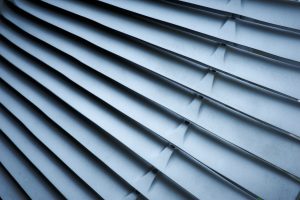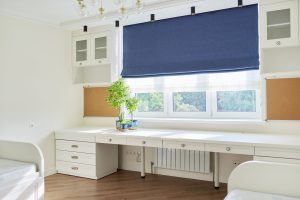Roller blinds can be a game-changer for your home’s energy efficiency. By acting as thermal barriers, they help regulate indoor temperatures, minimising heat loss in winter and reducing heat gain in summer. This precise control can lead to significant savings on energy bills. When custom-fitted, roller blinds optimise insulation, offering potential annual savings of up to 10% on heating and cooling costs. But what makes them stand out compared to traditional window treatments?
Key Takeaways
– Roller blinds act as thermal barriers, reducing heat loss in winter and minimising heat gain in summer.
– Custom-fitted roller blinds enhance insulation properties, minimising drafts and thermal leakage.
– Light-coloured or reflective roller blinds decrease reliance on air conditioning by reflecting solar heat.
– Roller blinds allow precise control of natural light, reducing the need for artificial lighting.
– Studies indicate roller blinds can achieve up to 10% savings on annual heating and cooling costs.
Understanding the Basics of Roller Blinds
Roller blinds, a popular choice for window coverings, offer more than just aesthetic appeal. You’ll find various roller blind types, each with distinct functionalities that enhance your living space. Light filtering blinds, for instance, strike a balance between privacy and natural illumination, allowing diffused sunlight to permeate your room. This not only reduces glare but also mitigates UV exposure, preserving your interiors.
Choose from blackout, sunscreen, and translucent fabrics, each serving specific needs. Blackout blinds provide maximum privacy and light blockage, ideal for bedrooms. Sunscreen blinds maintain your view while reducing heat and glare. Translucent options offer moderate light filtering, perfect for common areas. Each type of roller blind combines functionality with a sleek design, seamlessly integrating into modern decor.
The Role of Roller Blinds in Temperature Regulation
While you mightn’t immediately associate window coverings with energy efficiency, roller blinds play a significant role in regulating indoor temperatures. Their design offers effective temperature control by providing insulation benefits that reduce heat gain in summer and minimise heat loss in winter. The fabric and material choice are critical; they determine how well roller blinds insulate your windows.
Consider these analytical insights:
– Thermal Barrier: Roller blinds act as a barrier, minimising chilly drafts from entering and warm air from escaping.
– Heat Reflection: Light-coloured or reflective blinds can reflect sunlight, reducing indoor heat accumulation.
– UV Protection: By blocking UV rays, they protect interiors while maintaining a cooler environment.
– Custom Fit: Precision fitting enhances the blinds’ insulation properties, ensuring minimal gaps for temperature fluctuations.
Roller blinds are an effective solution for temperature regulation.
How Roller Blinds Contribute to Energy Savings
By integrating roller blinds into your home, you can achieve notable energy savings. These blinds offer precise light control, allowing you to optimise natural light while minimising the need for artificial lighting. During daylight hours, adjusting the blinds can reduce glare and maintain comfortable interior illumination, which can decrease your electricity usage.
Roller blinds also act as thermal barriers, minimising heat transfer through windows. In summer, they reflect solar heat, reducing reliance on air conditioning. Conversely, in winter, they help retain heat, lowering heating demands. Studies indicate that using roller blinds can lead to energy savings of up to 10% on annual heating and cooling costs. Selecting the right fabric and opacity enhances their efficiency, enabling tailored energy management for your home.
Comparing Roller Blinds With Other Window Treatments
When comparing roller blinds to other window treatments, it’s essential to evaluate their performance regarding energy efficiency, versatility, and cost-effectiveness. Roller blind styles offer superior light control compared to alternatives like curtains or shades. Their design minimises gaps, reducing heat transfer and enhancing insulation.
Evidence suggests that well-fitted roller blinds can lower energy bills by up to 30%. They’re versatile, adapting to various window sizes and offering options like blackout or sheer, which cater to specific light control needs. Analysing cost, roller blinds often provide a more budget-friendly solution without sacrificing functionality. Consider these factors:
– Energy Savings: Proven insulation advantages.
– Light Control: Customisable to your preferences.
– Versatility: Suitable for diverse window dimensions.
– Cost-Effectiveness: Affordable yet efficient.
Material Choices and Their Impact on Energy Efficiency
Having explored roller blinds‘ advantages over other window treatments, it’s now pertinent to scrutinise the materials used in their construction and how these choices affect energy efficiency. Different material types offer varying insulation effectiveness, which is essential for maintaining indoor temperatures. Fabrics with high density and advanced thermal properties can greatly reduce heat loss during colder months and minimise heat gain in warmer periods.
Light filtering capabilities and UV protection are equally important, affecting how much sunlight enters your home and potentially fades interiors. Colour choices also play a part; lighter colours reflect sunlight, enhancing cooling, while darker shades can absorb warmth. Opting for eco-friendly options not only benefits the environment but also aligns with sustainable energy use.
Installation Tips for Maximising Energy Efficiency
To enhance the energy efficiency of roller blinds, precise installation is key. Start by employing proper installation techniques to guarantee a snug fit. Gaps between blinds and windows can lead to heat loss or gain, thereby reducing efficiency. Aim for ideal positioning by mounting blinds as close to the window as possible. This minimises air exchange and enhances insulation.
Consider these installation tips:
– Measure accurately: Confirm exact measurements for a tight fit, reducing thermal leakage.
– Use quality brackets: Secure brackets provide stability, preventing gaps over time.
– Position for minimal gaps: Align blinds to cover entire window areas, maximising coverage.
– Consider side channels: Add side channels to further reduce air infiltration and improve thermal performance.
Seasonal Adjustments and Their Benefits
Achieving a snug installation sets the stage for the next step: optimising roller blinds according to seasonal changes. Begin by conducting energy audits to understand your home’s thermal dynamics. In winter, keep blinds open during sunny days to harness solar heat, and close them at night to retain warmth. During summer, close blinds during peak sun hours to reduce cooling loads.
Regular seasonal maintenance, such as checking for wear and ensuring smooth operation, enhances performance. Evidence suggests that strategic adjustments can lead to remarkable energy savings. Data supports that aligning blind usage with weather patterns maximises insulation, reducing reliance on heating and cooling systems. By adapting your blinds seasonally, you can considerably boost your home’s energy efficiency.
Cost Considerations and Potential Savings
While investing in roller blinds may initially seem like an additional expense, the long-term savings in energy costs can be substantial. Conducting a detailed cost analysis helps you understand the upfront investment compared to potential savings. Roller blinds can reduce heat loss in winter and minimise heat gain in summer, leading to lower utility bills. Savings projections indicate potential reductions in energy usage by up to 30%, depending on your climate and home insulation.
– Initial investment: Consider the cost of materials and installation.
– Energy savings: Analyse potential reductions in heating and cooling expenses.
– Return on investment: Estimate the time required to recoup your initial costs through savings.
– Durability and maintenance: Evaluate the lifespan and upkeep costs, impacting long-term savings.
With these insights, you can make informed financial decisions.
Environmental Impact of Using Roller Blinds
When considering the environmental impact of roller blinds, it’s essential to examine their role in enhancing energy efficiency and reducing carbon footprints. Roller blinds offer significant environmental benefits by effectively regulating indoor temperatures, which minimises the need for excessive heating or cooling. This reduction in energy consumption directly translates to a lower carbon footprint.
Moreover, the choice of sustainable materials in manufacturing these blinds further enhances their green credentials. Many roller blinds are crafted from recycled or eco-friendly fabrics, contributing to a more sustainable home environment. By selecting blinds made from sustainable materials, you support eco-conscious practices and promote a circular economy. Ultimately, integrating roller blinds into your home isn’t just about style; it’s a strategic move toward sustainability and environmental responsibility.
Frequently Asked Questions
Can Roller Blinds Be Automated for Convenience and Energy Efficiency?
You can automate roller blinds for enhanced convenience and energy savings. Automated systems optimise sunlight control, reducing HVAC usage. Studies show automated blinds can lower energy costs by up to 10%, providing both comfort and efficiency benefits.
Are There Smart Roller Blinds Compatible With Home Automation Systems?
Yes, you can find smart roller blinds compatible with home automation systems. They support smart home integration, offering energy monitoring features. Analyse options with evidence-based precision to ensure maximum energy efficiency and seamless automation in your setup.
Do Roller Blinds Require Regular Maintenance to Ensure Energy Efficiency?
Think of roller blinds as the guardians of your home’s energy efficiency. Regular maintenance, including specific cleaning methods and careful fabric choices, ensures they perform at their best. You’re guaranteeing they continue to block unwanted heat and cold.
How Do Roller Blinds Affect Indoor Air Quality and Ventilation?
Roller blinds enhance air circulation by allowing controlled airflow when partially open. They also aid light filtration, reducing glare while maintaining sufficient natural light. This balance can contribute positively to indoor air quality and overall comfort.
Are Custom-Sized Roller Blinds More Efficient Than Standard Sizes?
Custom-sized roller blinds enhance efficiency by ensuring a precise fit, minimising gaps that cause heat loss. They improve heat retention compared to standard sizes, providing better insulation. Analysing thermal performance data supports their superior energy-saving potential.
Conclusion
Imagine the sun’s rays gently filtered through sleek roller blinds, casting a serene glow across your living space. These energy-efficient barriers regulate temperature, ensuring warmth in winter and coolness in summer. By precisely controlling natural light, they reduce your reliance on artificial lighting, ultimately trimming your energy bills. With the potential for up to 10% annual savings, roller blinds are a smart, cost-effective choice for a sustainable home environment, seamlessly blending functionality with environmental consciousness.
















